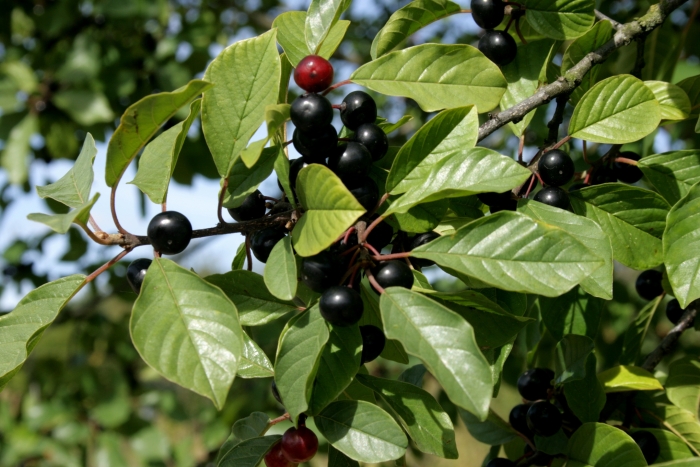Alder Buckthorn
(Frangula alnus)
Alder Buckthorn (Frangula alnus)
/
/

Sten Porse
CC BY-SA 3.0
Image By:
Sten Porse
Recorded By:
Copyright:
CC BY-SA 3.0
Copyright Notice:
Photo by: Sten Porse | License Type: CC BY-SA 3.0 | License URL: https://creativecommons.org/licenses/by-sa/3.0 | Uploader: Sten | Publisher: Wikimedia Commons | Title: Frangula-alnus-fruits.JPG | Notes: User created page with UploadWizard |




































































Estimated Native Range
Summary
Frangula alnus, commonly known as Alder buckthorn, is a deciduous shrub native to Europe, northern Asia, and northwest Africa. It is typically found in wetlands, along riverbanks, and in moist, deciduous forests, often associating with alder trees. Alder buckthorn grows to 3–6 m (10–20 ft) in height, occasionally reaching up to 7 m (23 ft), and can form a small tree with a trunk diameter of up to 20 cm (8 in). It is usually multistemmed, with smooth, dark gray bark. The leaves are ovate and slightly serrated, turning yellow in the fall. The small, star-shaped flowers are greenish-white, 3–5 mm (1⁄8–3⁄16 inch) in diameter, and bloom in clusters from May to June, offering a modest display. The plant produces small, red berries that turn black upon ripening.
Alder buckthorn is valued for its wildlife benefits, as the berries provide food for birds, and the flowers attract pollinators. It is used for hedging, in mixed shrub borders, and for naturalizing in wetland restoration projects. It is adaptable to a range of soil pH levels but prefers acidic conditions. While it can grow in full sun to part shade, it performs best with medium water availability and in soils with various drainage capabilities. Gardeners should be cautious, as Alder buckthorn can be invasive outside its native range, and its use may be restricted or discouraged in some regions.CC BY-SA 4.0
Alder buckthorn is valued for its wildlife benefits, as the berries provide food for birds, and the flowers attract pollinators. It is used for hedging, in mixed shrub borders, and for naturalizing in wetland restoration projects. It is adaptable to a range of soil pH levels but prefers acidic conditions. While it can grow in full sun to part shade, it performs best with medium water availability and in soils with various drainage capabilities. Gardeners should be cautious, as Alder buckthorn can be invasive outside its native range, and its use may be restricted or discouraged in some regions.CC BY-SA 4.0
Plant Description
- Plant Type: Shrub
- Height: 10-12 feet
- Width: 6-10 feet
- Growth Rate: Slow
- Flower Color: N/A
- Flowering Season: Spring
- Leaf Retention: Deciduous
Growth Requirements
- Sun: Full Sun, Part Shade
- Water: Medium
- Drainage: Fast, Medium, Slow
Common Uses
Bee Garden, Bird Garden, Butterfly Garden, Low Maintenance
Natural Habitat
Native to wetlands, riverbanks, and moist deciduous forests in Europe, northern Asia, and northwest Africa
Other Names
Common Names: Glossy Buckthorn, European Alder Buckthorn, Breaking Buckthorn, Glossy False Buckthorn, Faulbaum, Aulne Noir, Bourdaine, Bourgène, Nerprun Bourdaine, Brakved, Black Buckthorn
Scientific Names: , Frangula alnus, Frangula dodonei, Rhamnus autumnalis, Rhamnus sibirica, Frangula vulgaris var. subrotunda, Frangula alnus f. angustifolia, Frangula alnus var. elliptica, Frangula vulgaris var. parvifolia, Rhamnus frangula subsp. columnaris
GBIF Accepted Name: Frangula alnus Mill.